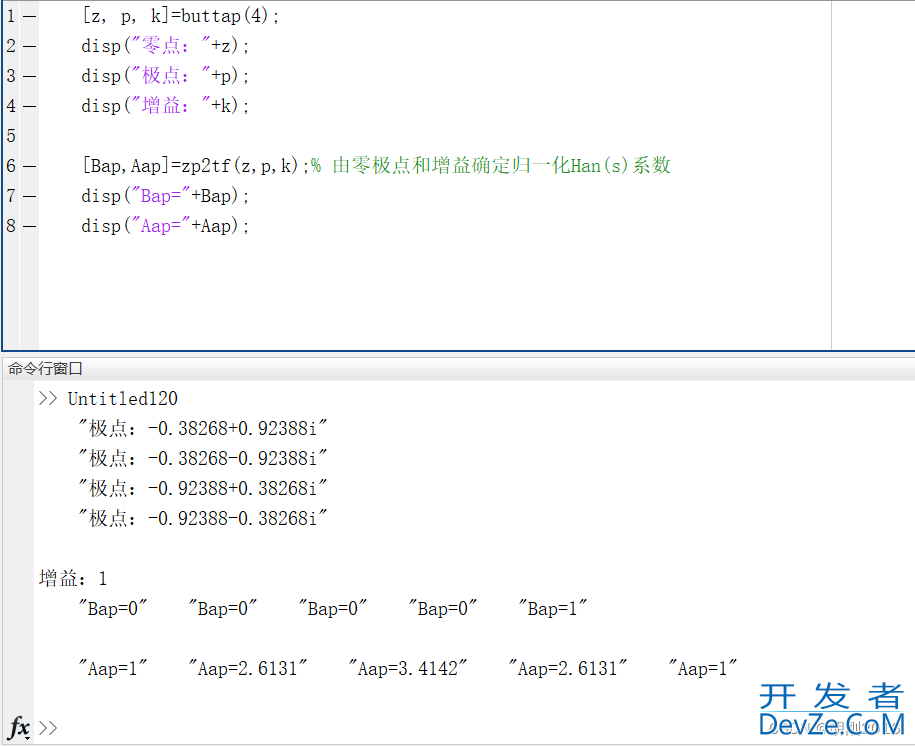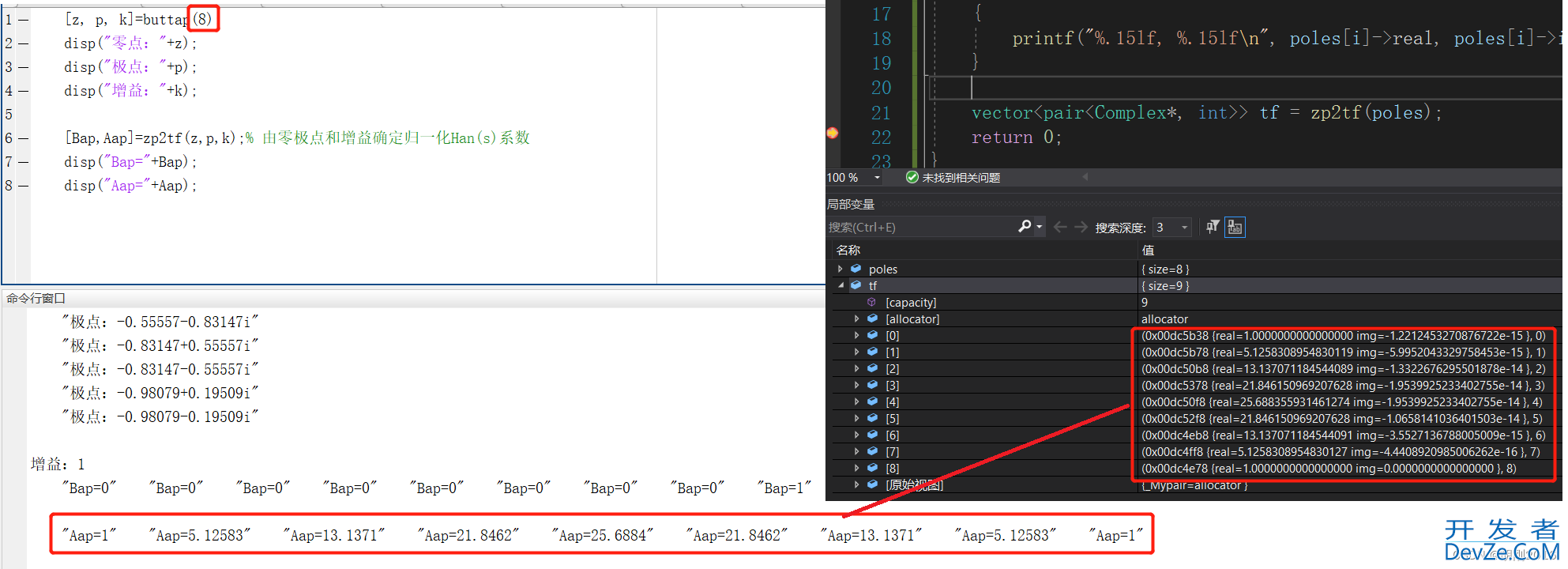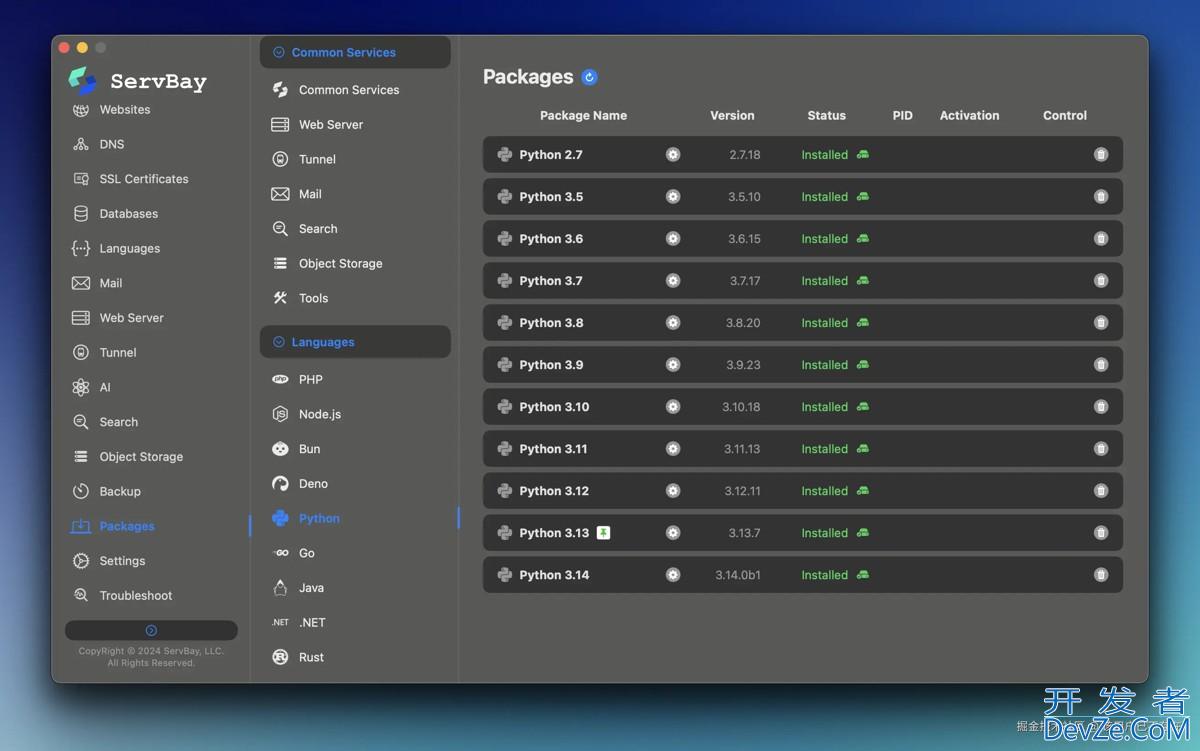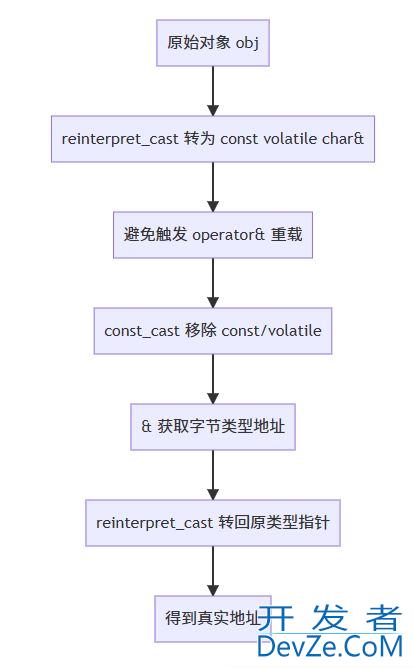目录
- 1. matlab 的 zp2tf 函数的作用
- 2. matlab 的 zp2tf 函数的使用方法
- 3. C++实现
- 3.1 complex.h 文件
- 3.2 zp2tf.h 文件
- 4. 测试结果
- 4.1 测试文件
- 4.2 测试结果
1. matlab 的 zp2tf 函数的作用
作用是将极点形式的 H(s) 函数的分母展开
2. matlab 的 zp2tf 函数的使用方法
[z, p, k]=buttap(4);
disp("零点:"+z);
disp("极点:"+p);
disp("增益:"+k);
[Bap,Aap]=zp2tf(z,p,k);% 由零极点和增益确定归一化Han(s)系数
disp("Bap="+Bap);编程客栈
disp("Aap="android+Aap);

3. C++实现
3.1 complephpx.h 文件
#pragma once
#include <IOStream>
typedef struct Complex
{
double real;// 实数
double img;// 虚数
Complex()
{
real = 0.0;
img = 0.0;
}
Complex(double r, double i)
{
real = r;
img = i;
}
}Complex;
/*复数乘法*/
int complex_mul(Complex* input_1, Complex* input_2, Complex* output)
{
if (input_1 == NULL || input_2 == NULL || output == NULL)
{
std::cout << "complex_mul error!" << std::endl;
return -1;
}
output->real = input_1->real * input_2->real - input_1->img * input_2->img;
output->img = input_1->real * input_2->img + input_1->img * input_2->real;
return 0;
}
3.2 zp2tf.h 文件
#pragma once
#include <iostream>
#include <math.h>
#include <vector>
#include "complex.h"
#define pi ((double)3.141592653589793)
using namespace std;
pair<Complex*, int> pair_mul(pair<Complex*, int> p1, pair<Complex*, int> p2)
{
pair&http://www.devze.comlt;Complex*, int> result;
Complex* new_coeff = (Complex*)malloc(sizeof(Complex));
int ret = complex_mul(p1.first, p2.first, new_coeff);
if (ret == -1)
{
cout << "pair_mul error!" << endl;
return result;
}
int new_pow = p1.second + p2.second;
result.first = new_coeff;
result.second = new_pow;
return result;
}
vector<pair<Complex*, int>> element_mul(vector<pair<Complex*, int>> element1, vector<pair<Complex*, int>> element2)
{
vector<pair<Complex*, int>> result;
if (element1.size() <= 0 || element2.size() <= 0)
{
cout << "element_mul error!" << endl;
return result;
}
for (int i = 0; i < element1.size(); i++)
{
pair<Complex*, int> p1 = element1[i];
pair<Complex*, int> p;
for (int j = 0; j < element2.size(); j++)
{
pair<Complex*, int> p2 = element2[j];
p = pair_mul(p1, p2);
if (result.size() == 0)
{
result.push_back(p);
}
else
{
bool merge_flg = false;
for (int k = 0; k < result开发者_Python培训.size(); k++)
{
// 如果指数一样,就合并
if (result[k].second == p.second)
{
result[k].first->real += p.first->real;
result[k].first->img += p.first->img;
free(p.first);
p.first = NULL;
p.second = 0;
merge_flg = true;
break;
}
}
if (!merge_flg)
{
result.push_back(p);
}
}
}
}
return result;
}
vector<pair<Complex*, int>> zp2tf(vector<Complex*> poles)
{
vector<pair<Complex*, int>> tf; // pair 的 first代表极点形式H(s)的分母展开后的每一项的系数,second 代表每一项的指数
if (poles.size() <= 0)
{
return tf;
}
// 先构造 n 个 (s-极点)
vector<vector<pair<Complex*, int>>> elements(poles.size());
for (int i = 0; i < poles.size(); i++)
{
vector<pair<Complex*, int>> element;
pair<Complex*, int> e1;
Complex* c1 = (Complex*)malloc(sizeof(Complex));
c1->real = -1.0 * poles[i]->real;
c1->img = -1.0 * poles[i]->img;
e1 = make_pair(c1, 0);// -1.0 * 极点
element.push_back(e1);
pair<Complex*, int> e2;
Complex* c2 = (Complex*)malloc(sizeof(Complex));
c2->real = 1.0;
c2->img = 0.0;
e2 = make_pair(c2, 1);// s
element.push_back(e2);
elements[i] = element;
}
if (elements.size() == 1)
{
return elements[0];
}
// 再将 n 个 (s-极点) 乘起来
vector<pair<Complex*, int>> element = elements[0];
for (int i = 1; i < poles.size(); i++)
{
vector<pair<Complex*, int>> result = element_mul(element, elements[i]);
if (result.size() <= 0)
{
return tf;
}
element = result;
}
return element;
}
4. 测试结果
4.1 测试文件
#include <stdio.h>
#include <stdlib.h>
#include <math.h>
#include <vector>
#include "buttap.h"
#include "zp2tf.h"
using namespace std;
#define pi ((double)3.141592653589793)
int main()
{
vector<Complex*> poles = buttap(4);
for (int i = 0; i < poles.size(); i++)
{
printf("%.15lf, %.15lf\n", poles[i]->re编程al, poles[i]->img);
}
vector<pair<Complex*, int>> tf = zp2tf(poles);
return 0;
}
4.2 测试结果
3阶模拟低通巴特沃斯滤波器

8阶模拟低通巴特沃斯滤波器

结果与 matlab 均一致,大家可以自行验证
以上就是C++实现Matlab的zp2tf函数的示例代码的详细内容,更多关于C++实现Matlab zp2tf函数的资料请关注我们其它相关文章!








 加载中,请稍侯......
加载中,请稍侯......
精彩评论